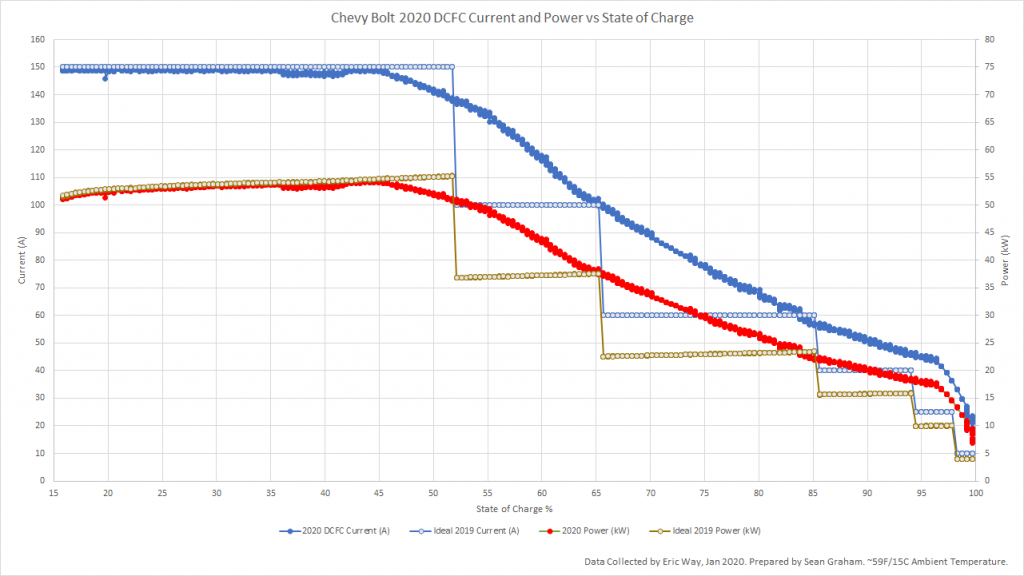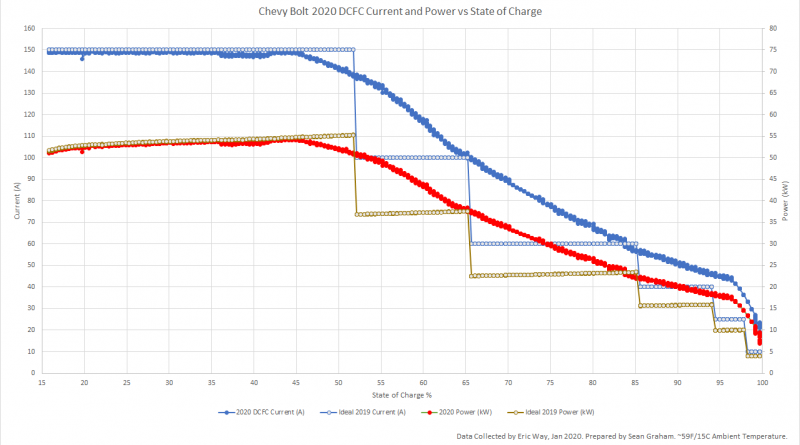Chevy Bolt 2020 DCFC Charge Curve
Thanks to the data collected by Eric Way, we now have a real picture of what the 2020 Bolt charging curve looks like.

Power is in Orange and on the right axis.
Current is in Blue and on the left axis.
The primary thing to notice is that they have done away with the artificial charging taper that was previously employed in 2019 and earlier models. I have overlaid that in the graph for comparison. I assume that all of the data that GM collected showed them that it was an unnecessary precaution.
What’s really nice about this is it exactly matches what I expected: the artificial taper was designed to trigger at the point where the natural taper would have started to drop the current below that level. In other words, for example, as soon as the natural taper reached 100 amps, they would drop it down to 60. Now they don’t do that second part; they just left the battery naturally decrease the current drawn once the charging reaches full voltage.
What’s the net result of this?
Comparing as if both batteries were the same size, Before from 50 to 85% it would have taken 45 minutes (using only the new 55+kW DCFC Chargers). Now it’ll take about 35 minutes. From 50 to 95% it would have taken 65 minutes, now it’ll take about 50. So you’ll save 10 minutes on charging if you drive between 10 and 85%.
This makes it a lot more palatable to charge up to 80% when you’re on a road trip, and topping up is also faster.
But don’t forget, you get 8% more range too!
Taking everything into consideration, on a long road trip where you drive 65mph and assuming that you still drive between 10 and 85%, ideal circumstances in a 2020 you will average 45.5mph (including charge time) as opposed to 43mph before, saving you ~5% on your trip time. Driving 430 miles will take 9.5 hours, saving you a half an hour from the 2019 and earlier models.


Pingback: Will GM Give 2017-2019 Bolts The 2020 DCFC Updates? – All EV Info
Awesome data! I’d love to see some low level data on energy used to get from 1 speed to another using fast acceleration or slow. For example if I go from 25 to 45 by flooring it, does it really use much more power than if I just gently accelerate up to 45. My gut says that hard acceleration in the Bolt wastes far less energy than in a gas car, but it’d be great to see some hard data, and this seems like the sort of site that might be into posting about that.
In an ice car, accelerating at 75% full throttle you avoided pumping losses . So using my gut tells me that like on my bike gentle acceleration is easier then peddling very hard and then maintaining. But as you suggest it would be nice to have a qualified opinion
Is there a way to get Chevy to “fix” my 2017 so that it doesn’t throttle back the charge?
Yes, with the changed battery, your Bolt EV 2017 will have the same charging curve.
This is great information, thank you for providing it. Would it be possible to post the data in a spreadsheet or JSON? I would like to integrate over time to give the Y axis in KWh (energy rather than power) with a few scenarios. (start/stop) battery charge points. Just completed a 1500 mile road trip and having the data in that form would be more useful for my return trip. I drive a 2019.
still looking for this?
Seconding Andrew’s request, it would be great to have the raw data used for these DCFC charge curves (and other charts on the site as well)! Appreciate all the work you put in!
Pingback: 2022 Chevrolet Bolt EUV and EV announced with almost everything you asked for - All CyberTruck
Pingback: 2022 Chevrolet Bolt EUV and EV introduced with nearly every part you requested for | Gadget News Plus
Pingback: 2022 Chevrolet Bolt EUV and EV announced with almost everything you asked for - Go Zip Zap Zoom
Pingback: 2022 Chevrolet Bolt EUV and EV announced with almost everything you asked for - Informers News
Pingback: 2022 Chevrolet Bolt EUV and EV announced with almost everything you asked for - Science Metro
Pingback: 2022 Chevrolet Bolt EUV and EV announced with almost everything you asked for – Automotive – Technology – Gadgets Reviews
Pingback: Can you drive from SW Colorado to Michigan in a 2018 Battery Powered Chevy Bolt? YES YOU CAN! Part II - EV Four Corners
Pingback: Your Next Car Should Be Electric - Profit Greenly
Sean or Eric, do you know if 2017-2019 Bolts with newly replaced batteries under the final recall remedy are updated to allow for the smooth curve, or if they still use the step function?
“smooth” curve, but it’s heavily influenced by the pack temperature. I got mine replaced in October, so I haven’t had a chance to see it’s true warm charging profile yet.